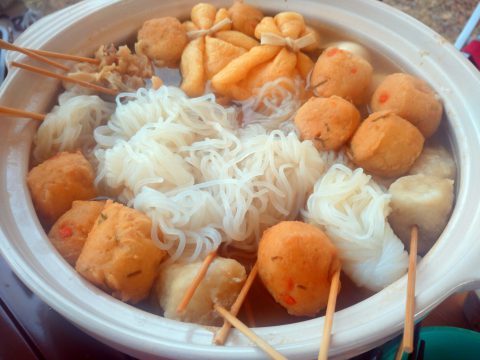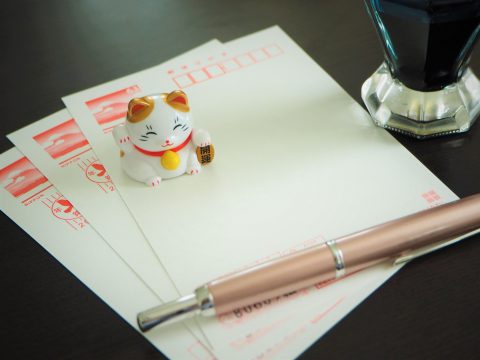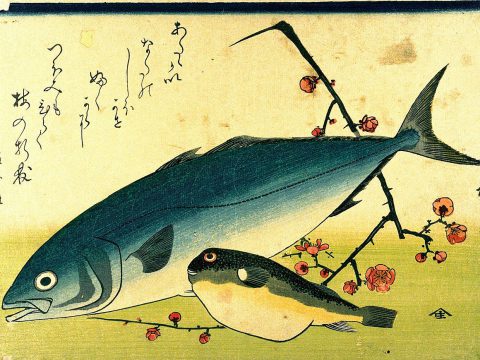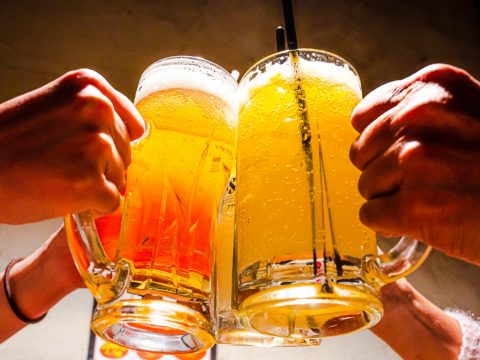Japanese Spring Desserts
JAPANESE FOODS
01.04.2022
In Japan, spring is the season of hellos and goodbyes. It’s when the school year ends and starts, new recruits start their first day of work, and the business year begins. It’s also the season of cherry blossoms, a sure sign that warm and pleasant weather is on its way.
Let’s take a look at the Japanese traditional confectionery or wagashi (和菓子) you may encounter during this time.
Sakura Mochi 桜餅
This is a pink-tinted oblong pancake with sweetened red bean paste in the center. It’s wrapped with pickled cherry blossom leaves. The thin pancake consists of wheat flour and shiratamako (glutinous rice flour), which gives it a slightly chewy texture. This type of sakura mochi is often seen in the Kanto area (where Tokyo is located).

Sakura Mochi/Sakura Doumyouji 桜餅・桜道明寺
This version of sakura mochi is made of doumyouji-ko (a coarse glutinous rice flour made of sticky rice). Similar to the Kanto style, it’s also tinted a blush pink, with a red bean paste filling, and wrapped in a cherry blossom leaf. This is often found in the Kansai area (where Kyoto and Osaka are located).

Sakura Jouyo 桜薯蕷
Jouyo is a type of wagashi made of grated yams and joshinko (rice flour). It has a fluffy and moist texture and is stuffed with red bean paste. It’s white and circular. The spring version of jouyo often has a pickled cherry blossom on top.
Kusamochi 草餅
A mochi with a red bean paste filling. The green color from the use of Japanese mugwort, also known as yomogi (蓬). This herb was said to dispel evil spirits and so was often eaten or hung around the house. The vivid green color also resembles fresh leaves.

Hanami Dango/Sanshoku Dango 花見団子・三色団子
This tri-color dango (skewered mochi balls) is colored pink, white, and green. The color scheme is said to symbolize the cherry trees: pink is the cherry blossoms, white is the snow on the trees, and green are the leaves. There’s another theory that the three colors represent the seasons: pink is spring, white is winter, and green is summer. Fall is not included, due to the pun “aki nai 飽きない・秋ない” (“no fall” and “won’t get tired”).

Uguisu 鶯
Uguisu, or bush warbler is a favorite spring motif for centuries, recorded in poems and literature. It’s also the name of the wagashi, which may be shaped like the bird. It can be made of kneaded white bean paste or be oval-shaped and made of mochi. Regardless of the shape, its usually colored light green. Additionally, it may be given a dusting of matcha powder or kinako (roasted soy bean flour).

There’s also lots of non-traditional desserts, which features spring motifs. But cherry blossoms reigns the most popular this time of year.
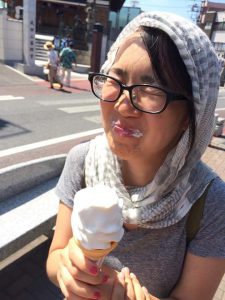
Kayoko Hirata Paku
Kayoko Hirata Paku is a food writer, translator, and bagel person. Growing up in Japan and the U.S., she currently resides in Tokyo with her peanut butter addicted husband, a very hungry baby, and many half-dead plants.
Read previous articles by the writer
Read latest articles
KEYWORDS
- # PICKPICK
- # Resume
- # alcohol
- # Rice
- # Soup
- # winter food
- # Fast Food
- # seafood
- # spicy foods
- # raw food
- # fermented food
- # Transportation
- # MEAT
- # Edo culture
- # suits
- # clothing
- # drink
- # fish
- # seasoning
- # Japanese New Years Foods
- # Toshikoshi soba
- # Osechi Ryori
- # Ozoni
- # Christmas
- # Japanese fusion pasta
- # Wafu Pasta
- # Japanese Hot Pot
- # なべ
- # 鍋
- # Miyazaki
- # Chicken Nanban
- # Karamen
- # Autumn Wagashi
- # Mushi-yokan
- # Imo-yokan
- # Japanese Autumn Fruits
- # Autumn
- # Vending Machine
- # fall
- # dango
- # Chestnut rice
- # saury
- # Mushroom
- # Rice vinegar
- # Japanese condiments
- # 調味料
- # Sake
- # Mirin
- # Soy sauce
- # Japanese Noodles
- # Udon
- # Ramen
- # Yakisoba
- # Soba
- # Japanese Seaweed
- # 海藻
- # かいそう
- # Payslip
- # Training
- # Japanese summer foods
- # 和菓子
- # Wagashi
- # ryokucha
- # 夏
- # 飲み物
- # Ramune
- # ラムネ
- # Pokari Sweat
- # ポカリスエット
- # Calpis
- # カルピス
- # Mugicha
- # ume
- # 梅
- # うめ
- # umeshu
- # job hunting
- # tofu
- # Recruitment in Japan
- # miso
- # Japanese cuisine
- # Yellowtail and bonito
- # Children’s Day
- # Kashiwa Mochi
- # Chimaki
- # fruits
- # Kusamochi
- # Types of Agriculture in Japan
- # bread
- # パン
- # パン屋さん
- # japanese bread
- # shokupan
- # meal blead
- # anko bread
- # 桜
- # さくら
- # cherry blossom
- # visa
- # hanami
- # omotenashi
- # sakura
- # おもてなし
- # Japanese hospitality
- # oshibori
- # wet hand towel
- # hand towel
- # restaurant
- # Commuting in Japan
- # Women-only cars
- # Exit gate
- # japanese train
- # train
- # valentine
- # Japanese sweets
- # 朝食
- # Japanese Breakfast
- # Breakfast
- # Japanese
- # 日本
- # healthy
- # persimmons
- # hoshigaki
- # HR
- # work in Japan
- # jinji ido
- # corporate systems
- # Japanese work culture
- # bento
- # ekiben
- # shinkansen
- # omiyage
- # train station
- # Japanese culture
- # work culture
- # mentaiko
- # umeboshi
- # Japanese snacks
- # potato chips
- # Japanese potato chips
- # Japanese writing
- # seaweed
- # konbu
- # ocean foods
- # shio konbu
- # dashi
- # miso soup
- # food processing
- # pear
- # nashi
- # sweet potato
- # japanese sweet potato
- # stingray
- # satsuma imo
- # food value chain
- # homecooking
- # agriculture
- # Japanese homecooking
- # farming
- # nikujaga
- # shojin ryori
- # meat and potatoes
- # traditional foods
- # comfort food
- # buddhist food
- # manufacturing
- # factory
- # eihire
- # vegetarian
- # food and beverage
- # izakaya
- # yatai
- # japanese festival
- # taiyaki
- # matsuri
- # summer
- # Ikayaki
- # smart agriculture
- # shaved ice
- # kakigori
- # かき氷
- # summer dessert
- # Japan
- # Japanese foods
- # dessert
- # fruit
- # matcha
- # icecream
- # Pikcup
- # Pikc up
- # Pcikup
- # skilled labor visa
- # working visa japan
- # Dineer Table in Japan
- # Japanese manner
- # Japanese food
- # Japanese Table Manner
- # Chopsticks
- # Japanese traffic signs
- # traffic information
- # road rules in Japan
- # chocolate
- # green tea
- # Osaka
- # Work Japan
- # Japanese company
- # ikura
- # sushi
- # nigiri
- # wasabi
- # PCIK
- # PICK UP
- # PICK
- # PICKUP


